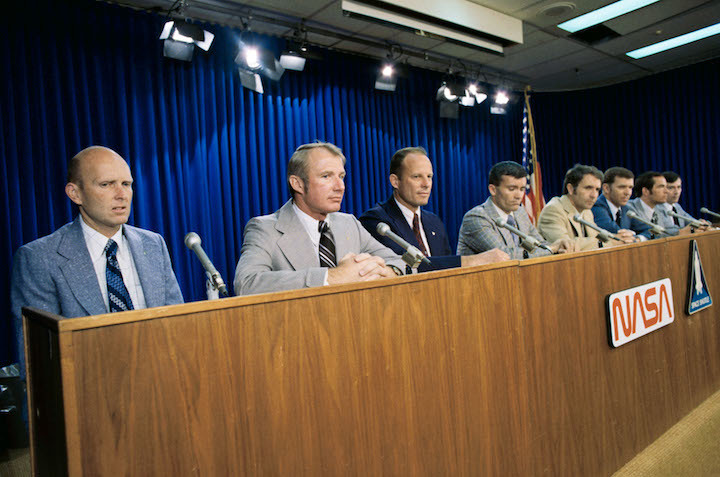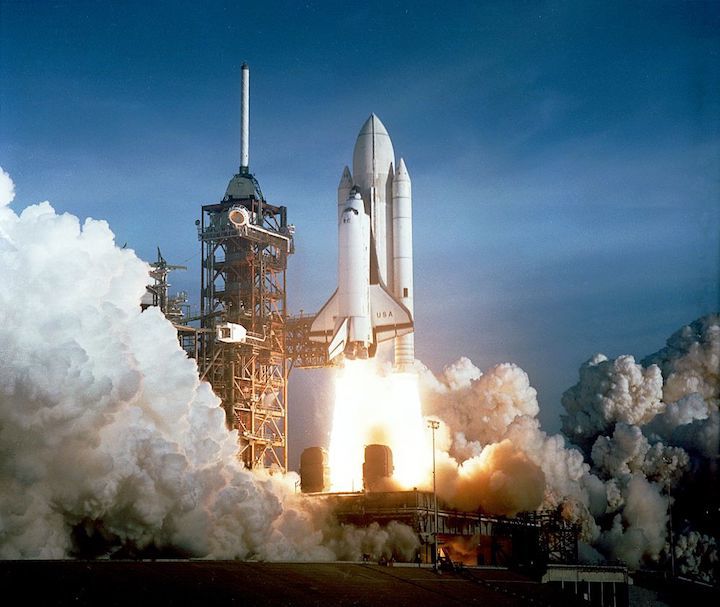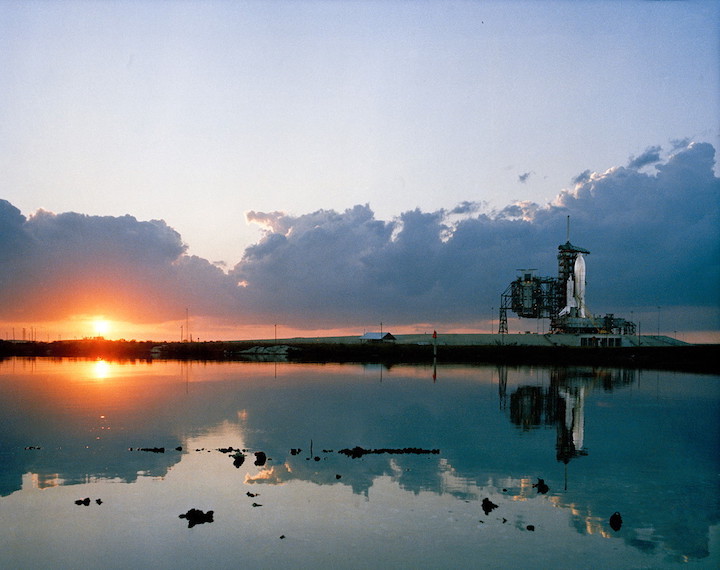12.03.2018

In March 1978, a “pool” of crew members were announced for the first four Orbital Flight Tests (OFTs) of the shuttle. At their initial press conference (from left) are Gordon Fullerton, Vance Brand, Jack Lousma, Fred Haise, Richard Truly, Joe Engle, Robert Crippen and John Young. Photo Credit: NASA
-
In the coming months, the first crews will be named for the maiden voyages of America’s first wholly-new piloted spacecraft in more than a generation. Since September 2014, Boeing and SpaceX have been working to develop their CST-100 Starliner and Crew Dragon vehicles for a series of critical test-flights, before committing both to International Space Station (ISS) crew-rotation missions. In doing so, U.S. astronauts will once again journey into space, aboard U.S.-built spacecraft, and from U.S. soil, for the first time since the end of the Space Shuttle era. Yet as America awaits its return to regular human access to space, we are reminded that four decades have passed since another group of crews were named for another wholly-new piloted spacecraft. In March 1978, only weeks after the selection of a new class of 35 astronaut-candidates, the first set of pilots were announced to fly the inaugural missions of the shuttle program.

Flying Enterprise for her test flights were (from left) Gordon Fullerton, Fred Haise, Joe Engle and Dick Truly. All four were assigned to the early Orbital Flight Tests (OFTs). Photo Credit: NASA
-
That month, forty winters ago, saw a quite different Astronaut Office to the one which endured through the 1980s, 1990s and into the present millennium. With the last manned lunar landing, the final expeditions to the Skylab space station and the Apollo-Soyuz Test Project (ASTP), a hiatus of several years would elapse before the world’s first reusable piloted spacecraft was due to take to the skies. By March 1978, a sizable number of the Mercury, Gemini and Apollo flyers had departed NASA for pastures new, leaving two unofficial subsets in the running for upcoming shuttle missions: the Grizzled Veteran Astronauts (not all of whom were, in fact, veterans) and the newly-arrived Thirty-Five New Guys (TFNGs).
There was an expectation that the first shuttle mission would occur in the spring of 1979, by which time the TFNGs would not yet have completed their yearlong training and evaluation period. So it was that on a cool March day in 1978, shuttle Enterprise arrived at Ellington Field in Houston, Texas, en-route from Edwards Air Force Base, Calif., to NASA’s Marshall Space Flight Center in Huntsville, Ala. Two men happened to be walking around the shuttle, when George Abbey, then-head of NASA’s Flight Crew Operations Directorate, stopped and looked the other straight in the eye.
“Hey, Crip, would you like to fly the first one?”

Young and Crippen depart the Operations & Checkout (O&C) Building for arguably the most hazardous human space launch ever attempted by the United States. Photo Credit: NASA
-
Bob Crippen had been an astronaut for almost nine years, yet was still awaiting his first spaceflight. This was the best news of his career. “I had anticipated that I would get to fly on one of the shuttle flights, early on,” he told the NASA oral historian, “because there weren’t many of us in the Astronaut Office during that period of time.” But to be named to STS-1, the very first mission by a new spacecraft, was beyond his imagination. A few days later, on 16 March, the news was official. Commanding the shuttle’s maiden flight was Chief Astronaut John Young, a veteran of four previous missions, including two voyages to the Moon and one journey down to the lunar surface.
Other names for early shuttle flights were a mix of experienced flyers and rookies. Apollo 13 veteran Fred Haise, together with Joe Engle, Dick Truly and Gordon Fullerton, had previously flown Enterprise for a series of Approach and Landing Tests (ALTs) at Edwards in the summer and fall of 1977. Rounding out the group were Skylab veteran Jack Lousma and ASTP veteran Vance Brand. The original line-up envisaged as many as six Orbital Flight Tests (OFTs) by Columbia, to evaluate not only the orbiter herself, but also her myriad capabilities, including the Canadian-built Remote Manipulator System (RMS) mechanical arm. With Young and Crippen on the first (“A”) OFT mission, it was expected—but not formally confirmed—that Engle and Truly would fly the second (“B”), followed by Haise and Lousma (“C”) and Brand and Fullerton (“D”).

After a hiatus of almost eight years, Pad 39A returned to operational status with the launch of Columbia on 12 April 1981. Photo Credit: NASA
-
“Flight assignments for the others…will be made at a later date,” it was announced, after declaring only the assignments of Young and Crippen as solid. “NASA plans a series of six orbital flight tests, each of increasing complexity, to check out the nation’s first reusable spacecraft.” It was also noted that the first four OFT missions would land at Edwards, with subsequent flights targeted to terminate at the Shuttle Landing Facility (SLF) at the Kennedy Space Center (KSC) in Florida. However, the fifth and sixth OFT missions were always considered speculative and never appeared in anything other than draft.
In the meantime, the early shuttle crews already began to change. STS-3 astronauts Haise and Lousma were originally tasked to rendezvous and possibly reboost America’s ailing Skylab space station. Unfortunately, shuttle program delays and the effect of enhanced solar activity on Earth’s atmosphere in 1979 caused Skylab to re-enter earlier than anticipated. Haise resigned from NASA in June of that year and was replaced in command of STS-3 by Lousma. Meanwhile, Fullerton rotated off the STS-4 crew and into the right-hand pilot’s seat with Lousma, whilst another astronaut, Bob Overmyer, was drafted into STS-4 to fly right-seat to Brand.

After the Mercury, Gemini and Apollo programs, the arrival of the Space Shuttle marked a new dawn for America’s space ambitions. Photo Credit: NASA, via Joachim Becker/SpaceFacts.de
-
By the end of 1979, the number of OFTs had indeed been reduced from six to four and several key objectives for the fifth and sixth flights—which included landing at KSC, performing an Extravehicular Activity (EVA) in the new shuttle-specification space suit and handling fully-functional scientific payloads—were shifted onto “operational” missions. Completion of the four OFTs would allow the shuttle to be declared fully operational, at some point in the fall of 1980.
As circumstances transpired, getting the shuttle to the launch pad would prove a long and arduous process. Problems with brakes and tires, readiness of space suits and agonizing delays in the certification process for the Space Shuttle Main Engine (SSME) forced the schedule further and further to the right. Not until 12 April 1981—the 20th anniversary since Yuri Gagarin became the first man in space—would Young and Crippen finally board Columbia and rocket into space and into the history books. STS-1 was arguably the most audacious test-flight ever conducted. Never before had humans been launched into orbit on a totally untried space vehicle.
Nor has it happened since. In fact, when astronauts board Boeing’s CST-100 Starliner and SpaceX’s Crew Dragon in the coming months, they will do so in the knowledge that both spacecraft have been exhaustively tested in an unpiloted capacity. Both vehicles are slated for their maiden voyages in August 2018. As America prepares to launch its first wholly new spacecraft in more than a generation, the legacy and example of the early shuttle veterans reminds us of the inherent bravery of the men and women who choose, regardless of risk, to fly these machines and further the exploration of space.
Quelle: AS
